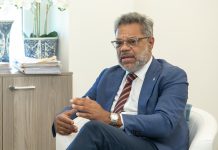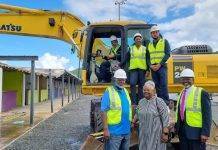Latin America and the Caribbean will grow in 2021, although the pandemic remains present and the crisis worsened the region’s long-standing structural problems: low investment and productivity, labor informality, unemployment, inequality and poverty. That is why recuperating investment and employment, especially in environmentally sustainable sectors, is key to a transformative and inclusive recovery, the Economic Commission for Latin America and the Caribbean (ECLAC) indicated today upon presenting a new edition of one of its most important annual reports.
The organization’s Executive Secretary, Alicia Bárcena, unveiled the Economic Survey of Latin America and the Caribbean 2021: Labour dynamics and employment policies for sustainable and inclusive recovery beyond the COVID-19 crisis, in which ECLAC updated its regional growth projection for this year to 5.9% and warned that the region will experience a deceleration in 2022, with an estimated expansion of 2.9%.
Growth in 2021 is mainly attributable to the low basis of comparison – after the 6.8% contraction recorded in 2020 – along with the positive effects arising from external demand and the rise in the price of the commodities that the region exports, as well as to increases in aggregate demand.
“There are important asymmetries between developed countries and middle-income nations, which includes the majority of countries in Latin America and the Caribbean, both with regard to the vaccination dynamic as well as the capacity to implement policies for the economic recovery,” Alicia Bárcena stated.
“In order to maintain expansionary fiscal and monetary policies, the region’s countries must complement domestic resources with greater access to international liquidity and with multilateral mechanisms that would facilitate debt management, if necessary. Multilateral initiatives are needed to face uncertainties about vaccination and developing countries’ access to financing under adequate conditions,” the senior United Nations official added.
The annual report shows that the structural problems that have limited the region’s economic growth for decades were exacerbated by the pandemic and will limit the recovery in economic activity. Before COVID-19, the region was already on a path towards stagnation: in the six-year period between 2014 and 2019, it grew at an average rate of 0.3%, below the average of the six-year period that includes the First World War (0.9%) and the Great Depression (1.3%). In addition, it has seen a steady decline in investment, reaching one of its lowest levels in the last three decades in 2020 (17.9% of GDP). Similarly, labor productivity is falling significantly.
Furthermore, in 2020, the pandemic sparked the biggest crisis that Latin America and the Caribbean’s labor markets have experienced since 1950. On a global level, the region’s labor markets were the most affected by the crisis prompted by COVID-19 – with the number of employed persons falling 9.0% in 2020 – and the recovery expected for 2021 will not be enough to attain pre-crisis levels.
The pandemic also led to a sharp decline in labor participation, particularly among women. With the crisis, female participation reached 46.9% in 2020, which represents a setback to levels seen in 2002. In 2021, this indicator is expected to recover, reaching an estimated 49.1%, but that would still only be similar to 2008 levels.
The Economic Survey underscores that ECLAC has proposed channeling investment into sectors that would promote a new development pattern and that can boost competitiveness and employment, and reduce the environmental footprint. These include: the transition towards renewable energy; sustainable mobility in cities; the digital revolution, to universalize access to technology; the health-care manufacturing industry; the bioeconomy and ecosystem services; the care economy; the circular economy; and sustainable tourism.
“Giving impetus to employment will require productive and labor policies to promote labor insertion, especially on the part of women and young people,” Alicia Bárcena stressed. She added that countries should expand programs that foster employment, especially among women and youth; spearhead sectoral policies for the reactivation of productive activities that were severely affected by the crisis, such as commerce and tourism; extend and deepen support programs for Micro, Small and Medium-sized Enterprises (MSMEs); and strengthen the care economy.
With regard to fiscal matters, the report emphasizes that fiscal policy should accelerate public investment and incentivize and attract private investment. To make fiscal policy sustainable, it is a priority for tax revenue to be bolstered and evasion to be reduced, since it represents around $325 billion dollars (or 6.1% of regional GDP).
In this area, greater access to international liquidity and multilateral mechanisms that would facilitate debt management would contribute to expanding the region’s fiscal and monetary policy space. The recently implemented issuance of Special Drawing Rights (SDRs) equivalent to $650 billion dollars will allow for strengthening the external position of the region’s countries, reducing risk and freeing up resources for fulfilling the Sustainable Development Goals (SDGs). But the issuance of SDRs and their reallocation is not a panacea and must be accompanied by other initiatives, including the creation of multilateral funds such as the Fund to Alleviate COVID-19 Economics (FACE), proposed by Costa Rica, to facilitate access to financing.
The report stresses the need to bolster regional, subregional and national development banks with the aim of increasing lending capacity and the capacity to respond to the pandemic, and to establish a multilateral sovereign-debt restructuring mechanism to handle the obligations contracted with private creditors. It also mentions the importance of mitigating the procyclical inclination of rating agencies and of contributing to financial stability becoming a global public good, through the creation of a multilateral credit rating agency.
“We must expand the toolbox of innovative instruments for improving access to financing and include middle-income countries in all initiatives involving debt relief and access to concessional liquidity. GDP must not be the sole criteria for evaluating countries’ development level and needs. We must move from graduation to gradation,” Bárcena emphasized.




























